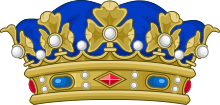
Back Pair van Frankryk Afrikaans Pair (Francie) Czech Pair de France German Pajraro de Francio (Malnova Reĝimo) Esperanto Par de Francia Spanish Ranskan päärit Finnish Pairie de France (Ancien Régime) French Paria di Francia Italian 프랑스의 대귀족제 Korean Pair van Frankrijk Dutch
This article needs additional citations for verification. (August 2019) |


The Peerage of France (French: Pairie de France) was a hereditary distinction within the French nobility which appeared in 1180 during the Middle Ages.
The prestigious title and position of Peer of France (French: Pair de France) was held by the greatest, highest-ranking members of the French nobility.[1] French peerage thus differed from British peerage (to whom the term "baronage", also employed as the title of the lowest noble rank, was applied in its generic sense), for the vast majority of French nobles, from baron to duke, were not peers.[note 1] The title of Peer of France was an extraordinary honour granted only to a small number of dukes, counts, and princes of the Roman Catholic Church. It was analogous to the rank of Grandee of Spain in this respect.
The distinction was abolished in 1789 during the French Revolution, but it reappeared in 1814 at the time of the Bourbon Restoration, which followed the fall of the First French Empire, when the Chamber of Peers was given a constitutional function somewhat along British lines which lasted until the Revolution of 1848. On 10 October 1831, by a vote of 324 against 26 of the Chamber of Deputies, hereditary peerages were abolished, but peerages for the life of the holder continued to exist until the chamber and rank were definitively abolished in 1848.
Following the Seven Years' War shortly before the French Revolution, some Canadian titles in the peerage of France came under the control of the British crown. All but one of these have either become extinct, or fallen into abeyance as their holders remained loyal to the French crown. The Baron de Longueuil holds the only French title of nobility that still exists today, as continued under the monarchy of Canada.
- ^ Ellis, Robert Geoffrey (1911). . In Chisholm, Hugh (ed.). Encyclopædia Britannica. Vol. 21 (11th ed.). Cambridge University Press. p. 55.
Cite error: There are <ref group=note> tags on this page, but the references will not show without a {{reflist|group=note}} template (see the help page).